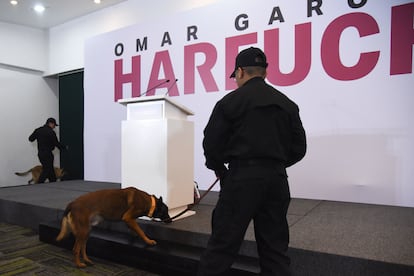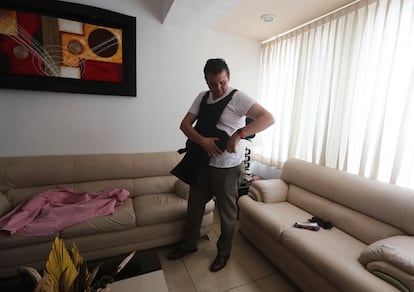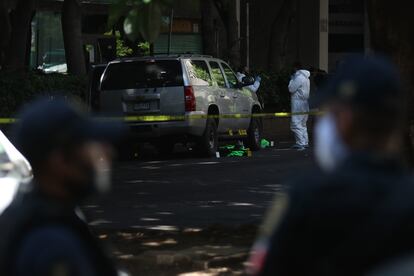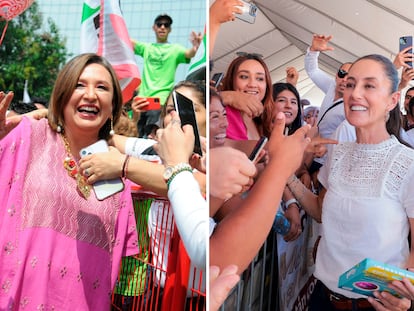Candidates in the crosshairs: the military takes over election security in Mexico
Presidential contenders will have Army protection for the 2024 campaign after over 100 people running for office in 2021 were killed


Mexican electoral campaigns are gearing up for potential violence as the country prepares for the June 2024 elections, which will have the highest number of positions up for grabs in history. The government recently announced that the two presidential candidates, Claudia Sheinbaum and Xóchitl Gálvez, will be provided with Army protection throughout their campaigns.
The country has been facing relentless terror for the last month, with corpses appearing everywhere, kidnappings, torture, burning of vehicles, drug blockades and executions. The López Obrador administration has admitted that the number of deaths during this six-year presidential term will be the highest in history. However, the violence isn’t limited to cartel terror, since many homicides are often blamed on clashes between rival gangs. Political disputes are sometimes settled by gun violence, not to mention all the election day incidents. According to the Noria Research organization, the 2021 midterm elections saw 101 politically-motivated homicides and numerous other crimes. Additionally, four candidates were kidnapped and their whereabouts remain unknown.
The turning point in Mexico occurred when Luis Donaldo Colosio was shot and killed in Tijuana on March 23, 1994. Colosio was heading to his vehicle after a campaign rally when the attack happened. Back then, political parties were responsible for providing their own security, which was lax at the time. Still, the levels of violence were significantly lower than now. The person who pulled the trigger was arrested, but the mastermind behind the crime has never been identified. Attributing such crimes to drug traffickers has become commonplace, but this has become meaningless, since the perpetrators often copy organized crime methods and use the same types of weapons and bullets. Faced by this kind of evidence, investigations are not pursued, even though some incidents may involve friendly fire.

Organizations in Mexico that track violence often rely on press reports for their statistics. Some individuals worry that security details (which candidates can request) are withdrawn after voting day, even though risks and unresolved disputes can persist regardless of the election outcome.
“Blaming drug traffickers for these crimes is very inadequate. It’s important to establish if the killers are seeking an election outcome or if they’re going after the candidate themselves. In the latter case, the danger may extend far beyond the election,” said María Teresa Martínez Trujillo, a professor at the Monterrey Institute of Technology and head of research for Mexico and Central America at Noria Research. Martínez, who is an expert in violence, points to Italy’s practice of merging a municipality at risk with other electoral districts to reduce the potential for criminal infiltration. This strategy makes sense in Mexico, as certain districts are highly sought after by criminal networks.
Most of the violence in an election period takes place in Mexico’s rural municipalities. Surprisingly, statistics show that a small-town mayor is more at risk than a presidential candidate, and they often distrust the police protection offered to them. Various administrations since the 1990s have recognized the problem and a number of protection protocols have been implemented for these candidates. “During President Felipe Calderón’s administration (2006-2012), political de-escalation teams were established in areas where conflict was anticipated, whether they were related to communities, land, or the political campaign itself,” said Martínez.
Mexicans live with violence — about 100 deaths a day on average — and are very accustomed to election crime. One might argue that political disputes are a smokescreen for the true motives of a crime. “Gender-based murder rates rise during election periods, especially when the perpetrator has a close relationship with the victim. And of course, drug traffickers are often blamed,” said Martínez. “Cases are judged based on the type of weapon and modus operandi, even though the motives and perpetrators remain unknown.”

There is no particular worry about the two female presidential candidates this year, as their political careers are not closely linked to addressing drug violence. However, one Morena candidate, who has not yet been nominated by his party, has made people very uneasy — Omar García Harfuch, who just resigned his position as Mexico City’s police chief to run for head of government in the capital city. Amid the ongoing primary elections, people hold their breaths as they watch García on television surrounded by crowds of devoted followers. They have reason for concern: García was on his way to work in 2020 when a firestorm of 400 bullets shredded his car, three of which hit him. After that, García practically lived in the police barracks. Until now.
“It would be naïve to assume that he is venturing out unprotected. As a police officer, he not only knows how to protect himself, and his team is also well-informed and prepared. He probably knows which neighborhoods and streets are unsafe, and the most dangerous times of day,” said Martínez, who is sure that police intelligence teams have all his routes covered. But the media still asks him whether he will visit Mexico City’s most dangerous places, like the Tepito neighborhood controlled by a powerful criminal mafia. García, the Morena party frontrunner, says he “feels safe, very calm during these [campaign] events.” He is protected by a group of unarmed guards and confirms that he has not yet asked for extra security.

While they never know where the bullet will come from or the motives behind an attack, every Mexican candidate recognizes the risks. They know their own weaknesses and strengths, and whether the enemy is a drug trafficker, a rival, or a traitor from within. It could be anyone.
Some states have been adding their own security measures to the ones offered by the federal government, but the most violent states aren’t among them, according to Noria Research. States like Veracruz, Michoacán, Puebla, and the State of Mexico. These aren’t the only dangerous places, of course. Opposition presidential candidate Xóchitl Gálvez started naming the states where she believed Army protection might be necessary and soon realized that it was a very long list. Mexico is currently experiencing a harrowing period of violence, and it’s easier to count the rare islands of peace amid all the turmoil.
Sign up for our weekly newsletter to get more English-language news coverage from EL PAÍS USA Edition
Tu suscripción se está usando en otro dispositivo
¿Quieres añadir otro usuario a tu suscripción?
Si continúas leyendo en este dispositivo, no se podrá leer en el otro.
FlechaTu suscripción se está usando en otro dispositivo y solo puedes acceder a EL PAÍS desde un dispositivo a la vez.
Si quieres compartir tu cuenta, cambia tu suscripción a la modalidad Premium, así podrás añadir otro usuario. Cada uno accederá con su propia cuenta de email, lo que os permitirá personalizar vuestra experiencia en EL PAÍS.
¿Tienes una suscripción de empresa? Accede aquí para contratar más cuentas.
En el caso de no saber quién está usando tu cuenta, te recomendamos cambiar tu contraseña aquí.
Si decides continuar compartiendo tu cuenta, este mensaje se mostrará en tu dispositivo y en el de la otra persona que está usando tu cuenta de forma indefinida, afectando a tu experiencia de lectura. Puedes consultar aquí los términos y condiciones de la suscripción digital.
More information
Archived In
Últimas noticias
Most viewed
- Oona Chaplin: ‘I told James Cameron that I was living in a treehouse and starting a permaculture project with a friend’
- Sinaloa Cartel war is taking its toll on Los Chapitos
- Reinhard Genzel, Nobel laureate in physics: ‘One-minute videos will never give you the truth’
- Why the price of coffee has skyrocketed: from Brazilian plantations to specialty coffee houses
- Silver prices are going crazy: This is what’s fueling the rally










































